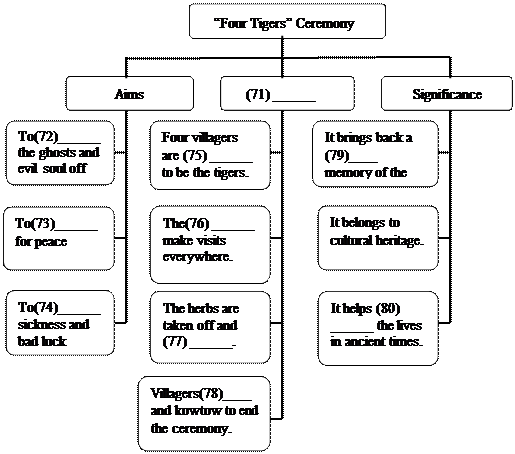
第四部分任务型阅读 (共10小题;每小题1分, 满分10分)
请认真阅读下列短文, 并根据所读内容在文章后表格的空格处里填人最恰当的单词。注意:每个空格填1个单词。
“Four Tigers” Ceremony of the Tu Minority
Heigouding Village, Ledu County in the west of Qinghai province is a place where many people of the Tu minority have lived for centuries. As the little village is comparatively closed to the outside world, a custom called “Four Tigers” was created 200 years ago to protect its inhabitants(栖息地) from sickness and bad luck.
Every year the ceremony is held on the eve of January 15th according to the Chinese lunar calendar to frighten off ghosts and evil souls, and to pray for peace.
Normally four local villagers are selected to be the “tigers” in the ceremony. At first, they gathered with village elders at the mountain-god temple to offer sacrifices of wine, food and incense, and to ask the god to help the tigers. Then the tigers were adorned with herbs, candles and two batches of incense to serve as the tiger’s ears. Two red ribbons held in their mouths represented the tiger’s tongue. The “Tigers” drank wine, knelt and kowtowed to the mountain god before they received Hada, a kind of white silk scarf representing respects and good luck, from the village head with firecrackers cracklin g.
g.
As night fell, the candles on the tigers’ bodies were lit and the tigers began their visits to one household after another. Villagers followed, shouting “Tigers are coming!” The elder from each household welcomed the tigers at the gate, while the rest of the family knelt down in the courtyard. Firecrackers were set off, a toast made and candies, meat and wine were presented to the villagers following the tigers. After twirling (快速转动)in three circles in the courtyard while those present kowtowed and prayed, the tigers went through every corner of every room to drive away any hiding ghosts. If there was a sick person in the house, the tigers jumped around him or her, scratched their body and said lucky words to drive away diseases and ghosts. After the ceremony, the family would present wine and food to the tigers. Then, shouting “The tigers are leaving!” the whole family saw them off.
After visiting all 30 or 40 households, the herbs were removed from the tigers and burned, to indicate that all the ghosts had been conquered. Then the villagers knelt and kowtowed with the sound of firecrackers, marking the end of the ceremony.
The tiger image exists in other minority groups, also. In ancient times, people entrusted their happiness to gods. The “four tigers” ceremony is vividly held in memory of ancient times and a living fossil for academics studying the lives of ancient people. As it is not popular nowadays, this cultural heritage is on the edge of extinction and needs to be rescued.